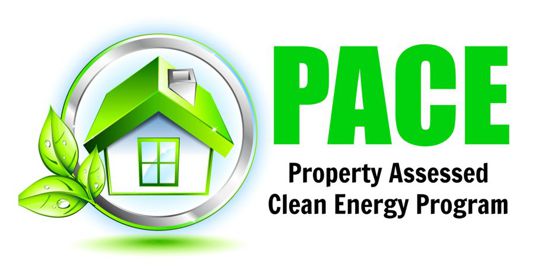Pleasanton Business Owners Eligible for Property Assessed Clean Energy Program
Pleasanton Business Owners Eligible for Property Assessed Clean Energy Program

Are you considering major energy upgrades? The property assessed clean energy (PACE) model is a mechanism that allows local residential and business property owners to finance renewable energy, energy efficiency, and water conservation improvements to their properties and repay the loan via an annual assessment on the owners' property tax bill.
Unlike traditional forms of credit that are dependent on an individual's credit rating, approval for PACE financing is primarily based on a property owner's equity in the building. Originally developed in Berkeley in 2007, PACE programs are now available throughout the United States and exist for both residential properties and commercial properties.
In 2011, the City of Pleasanton authorized one company to operate as a PACE provider, according to Derek Lee, Environmental Services Manager for the City of Pleasanton. Last year the city was approached by several other providers who also wanted to offer their services in Pleasanton; several of those providers included commercial PACE programs. In January 2018 the City of Pleasanton formally announced that it had broadened the number of PACE providers available to residents and business owners.
How PACE Works
PACE programs generally make it easier to finance expensive upgrades or renovations that may include solar electric, solar thermal, HVAC, roofing, windows/doors, and water conservation equipment. At least one authorized PACE provider even finances seismic strengthening projects. The type of improvements that covered vary from provider to provider, and some provide financing to residents only, business owners only, or both.
PACE providers usually offer 100% financing at a fixed interest rate over the useful life of the improvements, which may be up to 20 years. Moreover, these program providers generally have approved lists of contractors who are responsible for the improvements, so supporters see PACE programs as a way to create jobs as well as reduce energy consumption.
Anyone interested in using PACE financing for improvements should research the different options carefully and weigh the risks as well as benefits of this type of financing. What makes PACE financing possible is the addition of a new lien against the property that is being renovated or improved. This special assessment on one's property tax takes legal precedence over any mortgage.
"If there is ever a foreclosure, it gets paid back before the mortgage," says Lee. "So somebody might not want to back a mortgage if they know there is this kind of lien on the property."
Those who use PACE financing will not see the new payment due until the property tax bill is sent out. "Unlike a traditional mortgage that will hit you every month, you need to stash money to cover the additional cost," says Lee.
Lee also notes that contractors who work for PACE programs are prohibited from giving an estimate of increased property value based on any improvements they are doing. Making property improvements with PACE financing is no guarantee that there will be an increase in property value, he says, and that should not be a reason to use the program.
The City of Pleasanton has a climate action plan to reduce greenhouse gas emissions by 2020 to 15% below the city's 2005 levels of greenhouse emissions. The climate action plan "includes 167 initiatives, all designed to help the city meet that goal," says Lee, who notes that PACE programs are a good fit with the city's climate action plan.
PACE programs are not the only option for building owners who seek help in financing energy-smart upgrades to commercial properties. The Bay Area Multifamily Building Enhancements Program, for example, offers owners of properties with five or more attached units no-cost energy consulting and helps them plan improvements designed to save 15% or more of a building's energy and water usage.
The program assists in planning energy saving improvements designed to save 15% or more of a building's energy and water usage, Qualifying improvements include heating and cooling systems, water heating systems, energy-efficient lighting and appliances, building sealing, insulation, upgraded windows, and more. The program provides $750 per unit in rebates to help pay for the upgrades; property owners can apply for additional financial assistance through the Bay Area Multifamily Capital Advance Program.
Energy Upgrades Have Many Benefits
As Hacienda itself has discovered, energy upgrades can result in fiscal savings as well as a reduction in greenhouse gas emissions. Building energy upgrades are common throughout Hacienda and concerted efforts have been made to construct new buildings in energy efficient ways. Several projects in Hacienda have pursued clean energy generation. Large solar arrays are located on eight Hacienda sites, with three more planned installations in process and fuel cells are located at two sites. Cogeneration has also been used at two Hacienda projects to provide more efficient use of energy.
A few years ago Hacienda actively reduced the demand it placed on the electrical system through upgrades that saw the installation of everything from energy efficient equipment to clean energy systems. Beyond the long-term benefit of cost savings from projects whose payback periods were measured in months, not years, Hacienda has significantly reduced the energy demand for its infrastructure.
In conjunction with the City of Pleasanton, Hacienda also conducted energy efficient lighting retrofits throughout the park on selected features, most notably with the park's traffic signals, street lights, bus shelters, and decorative lighting. Hacienda also supports tenants who seek clean power and energy efficient upgrades. Many individual Hacienda projects have reaped their own savings through a variety of retrofit programs.
For more information about authorized PACE providers in the City of Pleasanton and the Bay Area Multifamily Building Enhancements Program, please visit www.cityofpleasantonca.gov/gov/depts/os/env/energy_and_sustainability.asp.




